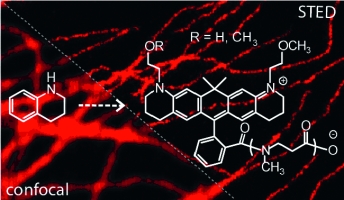 |
| Far-field optical nanoscopy methods, especially STED (stimulated emission depletion), pose very strict and, at times, contradictory requirements on the utilized fluorescent markers. Photostable fluorescent dyes that absorb in the red optical region are indispensable as labels for various micro- and nanoscopic studies (e.g., with commercially available STED microscopes). Despite many attempts to design novel and improved red-emitting dyes, the number of compounds that perform satisfactorily in fluorescence-based microscopy is still limited. |
Abstract:
Red-Emitting Dyes for Optical Microscopy and Nanoscopy
Written in Red
EU | Posted on July 7th, 2010Far-field optical nanoscopy methods, especially STED (stimulated emission depletion), pose very strict and, at times, contradictory requirements on the utilized fluorescent markers. Photostable fluorescent dyes that absorb in the red optical region are indispensable as labels for various micro- and nanoscopic studies (e.g., with commercially available STED microscopes). Despite many attempts to design novel and improved red-emitting dyes, the number of compounds that perform satisfactorily in fluorescence-based microscopy is still limited. Because of this, a great deal of research is being carried out by a large multidisciplinary team headed by Prof. Stefan W. Hell at the Department of NanoBiophotonics in Max Planck Institute for Biophysical Chemistry (Göttingen). In their recent paper published in the European Journal of Organic Chemistry the team describes a general synthetic route to new improved carbopyronine dyes and their performance in confocal and STED microscopy.
The new dyes have large fluorescence quantum yields, high water solubility, and the required positions of the absorption and emission bands in the red. The chemists came up with a synthetically feasible structural scaffold with functional groups that can be varied in the final steps of the synthesis or even in the resulting fluorescent dye to fit a given task. According to Dr. Kirill Kolmakov, who performed the synthesis, his "table book" contained a dissertation and articles and patents by Prof. K. Drexhage and co-workers, whose contribution to the synthesis of carbopyronines is fundamental. However, the synthetic approach presented in their EurJOC article is by far more flexible and improved. In particular, it starts from one simple precursor and utilizes a minimum amount of protecting groups. The key feature of the general strategy described therein is the interplay of certain protecting groups. Protecting groups will take an even more important part in the design and synthesis of caged carbopyronines and rhodamines that emit in the far-red spectral region. Besides the interesting chemistry, the team demonstrates that the performance of a dye in confocal microscopy and under STED conditions does not necessarily correlate. Dr. Kolmakov thus emphasizes that for their future research work, they will have to reconsider some of their old views on the "ideal" STED dye. All these make the primary article a good example of teamwork that is strategically sound, brilliantly planned, and perfectly delivered.
Author: Vladimir N. Belov, Max Planck Institute for Biophysical Chemistry, Göttingen (Germany),
Title: A Versatile Route to Red-Emitting Carbopyronine Dyes for Optical Microscopy and Nanoscopy
European Journal of Organic Chemistry, 2010, No. 19, 3593-3610, Permalink to the article: dx.doi.org/10.1002/ejoc.201000343
####
For more information, please click here
Copyright © European Journal of Organic Chemistry
If you have a comment, please Contact us.Issuers of news releases, not 7th Wave, Inc. or Nanotechnology Now, are solely responsible for the accuracy of the content.
| Related News Press |
News and information
![]() Researchers develop molecular qubits that communicate at telecom frequencies October 3rd, 2025
Researchers develop molecular qubits that communicate at telecom frequencies October 3rd, 2025
![]() Next-generation quantum communication October 3rd, 2025
Next-generation quantum communication October 3rd, 2025
![]() "Nanoreactor" cage uses visible light for catalytic and ultra-selective cross-cycloadditions October 3rd, 2025
"Nanoreactor" cage uses visible light for catalytic and ultra-selective cross-cycloadditions October 3rd, 2025
Announcements
![]() Rice membrane extracts lithium from brines with greater speed, less waste October 3rd, 2025
Rice membrane extracts lithium from brines with greater speed, less waste October 3rd, 2025
![]() Researchers develop molecular qubits that communicate at telecom frequencies October 3rd, 2025
Researchers develop molecular qubits that communicate at telecom frequencies October 3rd, 2025
![]() Next-generation quantum communication October 3rd, 2025
Next-generation quantum communication October 3rd, 2025
![]() "Nanoreactor" cage uses visible light for catalytic and ultra-selective cross-cycloadditions October 3rd, 2025
"Nanoreactor" cage uses visible light for catalytic and ultra-selective cross-cycloadditions October 3rd, 2025
Tools
![]() Japan launches fully domestically produced quantum computer: Expo visitors to experience quantum computing firsthand August 8th, 2025
Japan launches fully domestically produced quantum computer: Expo visitors to experience quantum computing firsthand August 8th, 2025
![]() Rice researchers harness gravity to create low-cost device for rapid cell analysis February 28th, 2025
Rice researchers harness gravity to create low-cost device for rapid cell analysis February 28th, 2025
|
|
||
|
|
||
| The latest news from around the world, FREE | ||
|
|
||
|
|
||
| Premium Products | ||
|
|
||
|
Only the news you want to read!
Learn More |
||
|
|
||
|
Full-service, expert consulting
Learn More |
||
|
|
||








